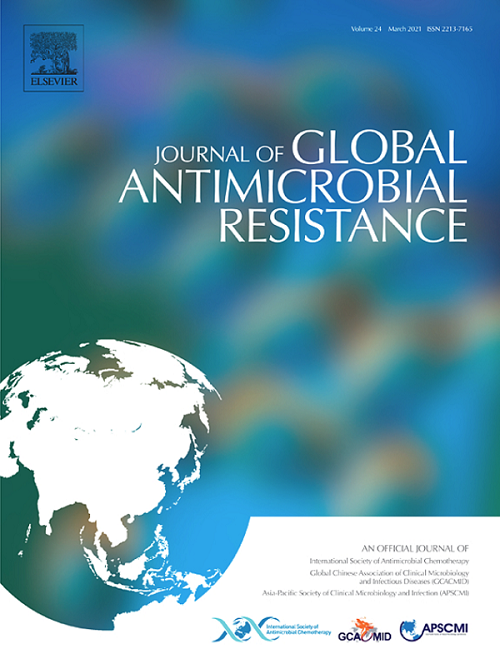新型噬菌体联合抗生素对产esbl和耐碳青霉烯大肠杆菌的治疗潜力。
IF 3.7
3区 医学
Q2 INFECTIOUS DISEASES
引用次数: 0
摘要
目的:产生广谱β-内酰胺酶(ESBL)的大肠杆菌和碳青霉烯耐药大肠杆菌(CREC)的出现是一个重大的全球健康挑战。本研究的重点是分离和鉴定两种新的噬菌体,EC。W1-9和EC。W15-4,并研究它们与抗生素对这些耐药大肠杆菌的疗效。方法:采用BALB/c小鼠进行体内实验,收集大肠杆菌分离株,进行培养,并进行药敏评价。从医院污水中分离噬菌体,制备感染大肠杆菌的噬菌体。结果:分离得到的噬菌体,EC;W1-9和EC。W15-4属于Podoviridae和Straboviridae科,缺乏整合酶或毒素编码基因,表明用于治疗是安全的。这些噬菌体的结合显著提高了它们的裂解能力,60株大肠杆菌的裂解率为61.7%,而单个噬菌体的裂解率为41.6%-55%。此外,该噬菌体组合对ST73、ST648、ST2311、ST405、ST7962、ST131、ST13003和ST167等不同大肠杆菌序列型均表现出100%的敏感性。此外,抗生素和噬菌体组合之间的协同作用将ESBL生产者的敏感性提高到73.3%,对CREC的敏感性提高到54%。分离噬菌体与抗生素联合治疗可显著提高暴露于耐药ST131、ST648和ST410大肠杆菌的BALB/c小鼠的存活率。与单个噬菌体相比,ST131的存活率提高了约75%和50%。两种噬菌体和抗生素联合治疗对大肠杆菌ST410和ST648的存活率分别为75-100%和100%。结论:本研究强调了噬菌体和噬菌体-抗生素联合治疗在对抗产生esbls的大肠杆菌和CREC分离株中的重要作用。本文章由计算机程序翻译,如有差异,请以英文原文为准。
Therapeutic potential of novel phages with antibiotic combinations against ESBL-producing and carbapenem-resistant Escherichia Coli
Objectives
The emergence of extended-spectrum β-lactamase (ESBL)-producing E. coli and carbapenem-resistant E. coli (CREC) is a significant global health challenge. This study focuses on isolating and characterizing two novel phages, EC.W1–9 and EC.W15–4, and investigating their efficacy with antibiotics against these resistant E. coli.
Methods
In vivo experiments were conducted using BALB/c mice, and E.coli isolates were collected, cultured, and evaluated for antibiotic susceptibility. Phages were isolated from hospital sewage and prepared to infect the E. coli.
Results
The isolated phages, EC.W1–9 and EC.W15–4, belonged to the Podoviridae and Straboviridae families, and lack integrase or toxin-coding genes, indicating safety for therapeutic use. The combination of these phages significently enhanced their lytic ability, lysing 61.7% of 60 E. coli isolates, compared to 41.6%–55% lysis by individual phages. Furthermore, the phage combination demonstrated 100% susceptibility against different E. coli sequence types, including ST73, ST648, ST2311, ST405, ST7962, ST131, ST13003, and ST167. Additionally, synergy between antibiotics and phage combinations improved susceptibility rates to 73.3% for ESBL producers and 54% for CREC. The combined treatment of isolated phages and antibiotics significantly increased survival rates in BALB/c mice exposed to resistant STs of E.coli, including ST131, ST648, and ST410. Survival rates against ST131 increased by approximately 75% and 50% compared to treatment individual phages. Combined treatment with two phages and antibiotics resulted in 75–100% survival against E. coli ST410 and 100% survival against ST648
Conclusions
This study highlights the therapeutic importance of phage and phage-antibiotic combinations in combating ESBL-producing E. coli and CREC isolates.
求助全文
通过发布文献求助,成功后即可免费获取论文全文。
去求助
来源期刊

Journal of global antimicrobial resistance
INFECTIOUS DISEASES-PHARMACOLOGY & PHARMACY
CiteScore
8.70
自引率
2.20%
发文量
285
审稿时长
34 weeks
期刊介绍:
The Journal of Global Antimicrobial Resistance (JGAR) is a quarterly online journal run by an international Editorial Board that focuses on the global spread of antibiotic-resistant microbes.
JGAR is a dedicated journal for all professionals working in research, health care, the environment and animal infection control, aiming to track the resistance threat worldwide and provides a single voice devoted to antimicrobial resistance (AMR).
Featuring peer-reviewed and up to date research articles, reviews, short notes and hot topics JGAR covers the key topics related to antibacterial, antiviral, antifungal and antiparasitic resistance.
 求助内容:
求助内容: 应助结果提醒方式:
应助结果提醒方式:


